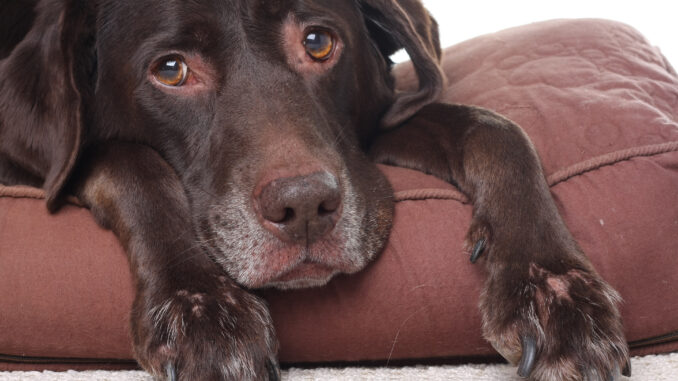
This article was updated on June 27th, 2023
From giving us companionship and unconditional love to providing us with endless entertainment, the connection you have with your dog is a special one and every owner only wants what’s best for their pet. The thought of your dog suffering in anyway is very distressing for owners, and there comes a point in many pets’ lives where having them humanely euthanized becomes the best thing you can do for them. In this article, we will review when is the best time to euthanize a dog with tracheal collapse to avoid unnecessary suffering for your furry friend.
Tracheal collapse causes the dog’s windpipe to collapse as a result of a weakness of the structures that hold it open. This leads to breathing problems that have wide-ranging effects on the dog’s overall health. While treatments are available, tracheal collapse is a condition that often gets worse with age and can become fatal without intervention.
One case came into my veterinary clinic recently. Lilly had long been treated for tracheal collapse and treatment was successful initially. However, over time, the medication she was on lost effectiveness. Lilly coughed almost constantly throughout the day. Even short walks left her out of breath. Finally, her owners decided Lilly’s quality of life was so poor they needed to take action. The most basic of activities caused Lilly distress and discomfort. Lilly’s family decided it was time to say goodbye and made the decision to put her to sleep.
How to recognize and respond to tracheal collapse
The main signs of tracheal collapse include:
- A distinctive “goose honking” cough
- Difficulty breathing, especially during exercise
- Coughing when pressure is applied to the dog’s neck, such as when pulling a lead
- Gagging or retching
- Cyanosis (gums turning blue) due to lack of oxygen intake
Tracheal collapse ultimately results in a lack of oxygen. Oxygen is essential for releasing energy for metabolism, and so a dog with tracheal collapse might be lethargic, reluctant to exercise, and struggling to breathe.
If your dog is coughing more than a few times a day, if the cough is becoming more frequent, or if your dog is otherwise unwell, you should take him to see your local vet.
Your vet performs various tests to officially diagnose tracheal collapse. A physical examination of your dog might reveal irritation when palpating the windpipe, often eliciting a cough. X-rays can show inflammation in the area and help rule out other common causes of a cough. And advanced imaging techniques such as CT scans, endoscopy, or fluoroscopy can help visualize the trachea collapsing as your dog breathes.
4 Stages of dogs’ tracheal collapse
Tracheal collapse gradually gets worse with time, and the sooner it is identified and treated, the better the prognosis will be for your dog. Vets use a grading system from 1-4 to describe the disease’s progress. The stages are as follows:
- Grade 1: Mild disease, the cells that line the inside of the trachea begin to lose their strength and shape. The tracheal lumen (space in which air can flow through), is reduced by about 25%. Often no to very mild symptoms are displayed at this stage.
- Grade 2: The tracheal lumen is reduced by about 50%. The c-shaped cartilaginous rings start to lose shape and become more flattened. Moderate symptoms such as a cough may be present.
- Grade 3: The tracheal lumen is reduced by about 75% and the cartilage is almost completely flattened. The dog will often have a cough and may show signs of breathing difficulty.
- Grade 4: The tracheal lumen is completely collapsed in on itself and the cartilage is completely flattened or even inverted. The dog will have a honking cough, breathing difficulties, and may become cyanotic.
Prognosis for dogs’ tracheal collapse
The long-term prognosis for dogs with tracheal collapse will depend on how soon the disease is identified and when treatment is started.
Weight control is extremely important in prolonging the lifespan of a dog affected with tracheal collapse. Obese animals will have a significant amount of extra fat around their windpipe, which can put added pressure on an already weakened trachea.
Dogs left untreated will show a gradual deterioration over time. The condition can become fatal if the trachea completely collapses; a collapsed trachea can result in asphyxiation and death.
Dogs treated with a surgical implant to help hold the trachea open can have good long term survival rates, with 86% of dogs surviving beyond 36 months after surgery. These dogs can continue to live a fairly normal life, but their exercise intensity may still have to be reduced. A dog with tracheal collapse may get out of breath faster than a healthy dog, and excessive exercise may put unneeded strain on the delicate tissues of the trachea.
Effectiveness of treatments for tracheal collapse
Veterinary treatments
Dogs in acute respiratory arrest will need stabilization and oxygen therapy. Short term medication such as anti-inflammatories and cough suppressants can relieve discomfort.
For milder cases of tracheal collapse, bronchodilators and steroids can help keep the airways open and reduce inflammation respectively. However, these will not stop the progression of the disease. For more severe cases of tracheal collapse, surgical intervention may be required. This usually involves inserting a stent or continuous extraluminal tracheal prosthesis (CETP), which essentially act as a prosthetic trachea, ensuring that it remains open.
Home treatments
While most cases of tracheal collapse will require veterinary intervention, there are many things that an owner can do to improve their affected dog’s quality of life. Keeping your dog in good shape is absolutely vital as excess fat around their neck will put extra pressure on the trachea so be sure to get your dog on a diet if they are overweight. Avoid collars or anything else that fits around your dog’s neck, use a harness instead. Avoid walking your dog in extreme hot or cold temperatures, too – too cold can cause throat irritation and too hot will result in excessive panting and strain on the trachea. It’s also important to minimize the use of aerosols, scent diffusers and don’t smoke around your dog, all of these will cause unnecessary irritation to the trachea.
When everything’s been done: The decision to euthanize
While tracheal collapse is a condition that can be treated successfully for months and even years, there will sadly be situations where the disease has progressed beyond management.
Dogs with end stage tracheal collapse may be constantly coughing, unable to get settled, and having difficulty breathing. These symptoms are very distressing for your dog and result in a poor quality of life. In very extreme circumstances, tracheal collapse may completely obstruct airflow in and out of the lungs, resulting in poor oxygen delivery and cyanosis.
It is at this point that owners might consider having their companion euthanized. While it is an excruciatingly difficult decision to make, the interests of your dog must come first. If they are unable to do something as simple as breath properly, then it isn’t fair to prolong their suffering.
The euthanasia process is completely painless and very quick for your dog, so you shouldn’t worry about it causing them distress. However, the situation of putting them in the car to take them to the vet can cause unwanted stress and anxiety for your dog. This will further exacerbate their condition. Consider arranging a home euthanasia visit if possible; your dog can be put to sleep in their own environment, reducing stress.
Our dogs bring us so much joy and pleasure over their lifetimes that it’s only right to return the favor when they develop a condition such as tracheal collapse. It’s an owner’s responsibility to care for their dog, and sadly sometimes that means making the tough decision to euthanize. You never have to make the decision alone – your vet is there to give you an unbiased view on when the time might be right. Think of the ability to euthanize a dog with tracheal collapse as a blessing: your friend won’t have to suffer any longer, and you can take solace in the fact that you did what was best for your pet.
What is tracheal collapse?
The trachea is the windpipe, the main airway that carries air in and out of the lungs when a dog breathes. Like in humans, a dog’s trachea is a muscular tube that is held open by C-shaped rings of hard cartilage. These rings of cartilage usually hold the windpipe open despite the rapid changes in air pressure that occur in the lungs.
However, in dogs with tracheal collapse, the rings of cartilage and the surrounding muscular structures are too weak to withstand these changes in air pressure. Therefore, the trachea is prone to collapsing, especially when a dog breathes in. This reduces the space through which oxygen can enter and carbon dioxide can leave the lungs. The collapsing walls of the trachea also become irritated, resulting in a characteristic “honking” cough.
Researchers believe that tracheal collapse is a congenital disorder, with certain breeds such as Yorkshire Terriers, Chihuahuas, Miniature Poodles, Pomeranians, and Pugs being more likely to develop it. Tracheal collapse also more commonly affects middle-aged to older dogs.

Frequently Asked Questions
Can Benadryl be used to help with tracheal collapse?
Generally, Benadryl will have little effect for dogs with tracheal collapse. It may help settle a cough in the short term, but long-term use is not recommended. Benadryl is an antihistamine medication and so it helps where allergies may be causing a dog’s cough. However, tracheal collapse is an anatomical abnormality and so this medication will have little effect.
Which dogs are most likely to experience tracheal collapse?
Tracheal collapse most commonly affects small breed dogs such as Chihuahuas, Yorkshire Terriers, Shih Tzus, Pomeranians, Lhasa Apsos and Miniature and Toy Poodles.
What causes Tracheal Collapse?
Tracheal collapse is thought to be a congenital disorder that results in a weakness in the structures that support and hold the windpipe open. This results in the gradual collapse of the windpipe over time.
Disclaimer: This website's content is not a substitute for veterinary care. Always consult with your veterinarian for healthcare decisions. Read More.


Thanks so much! The information was very informative.